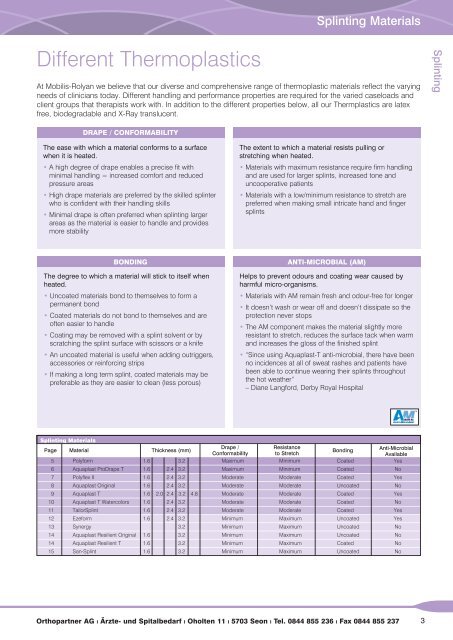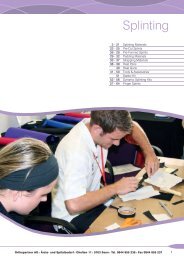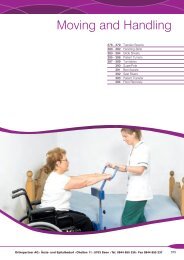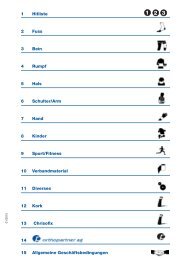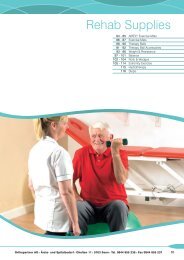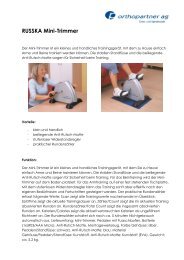- Page 3 and 4: ContentsMedical SuppliesSplinting 1
- Page 5: SplintingSplinting2 - 21 Splinting
- Page 9 and 10: Polyform & Polyform LightSplinting
- Page 11 and 12: Polyflex II & Polyflex II LightSpli
- Page 13 and 14: Aquaplast-TSplinting Materials2 Aqu
- Page 15 and 16: TailorSplintSplinting Materials1Tai
- Page 17 and 18: SynergySplinting Materials1SynergyM
- Page 19 and 20: San-Splint & San-Splint LightSplint
- Page 21 and 22: Anti-MicrobialSplinting Materials1
- Page 23 and 24: NeopreneSplinting Materials1 Neopre
- Page 25 and 26: Splinting Materials1 Adapt-It Therm
- Page 27 and 28: Pre-Cut Splints1 Wrist and Thumb Sp
- Page 29 and 30: Pre-Cut Splints1 Resting Pan Mitt S
- Page 31 and 32: Pre-Formed SplintsAnti-Spasticity S
- Page 33 and 34: Padding Materials1 100% Cotton Stoc
- Page 35 and 36: Padding Materials1 Contour FoamRoly
- Page 37 and 38: Strapping Materials1 Self-Adhesive
- Page 39 and 40: Strapping MaterialsSplinting1Velcro
- Page 41 and 42: Strapping Materials1SoftStrap Strap
- Page 43 and 44: Heat PansDigital version of our 9L
- Page 45 and 46: Tools & Accessories1 Splinting KitM
- Page 47 and 48: Tools & Accessories1 All-Purpose Sn
- Page 49 and 50: Tools & Accessories1 Nylon D-Rings2
- Page 51 and 52: Tools & Accessories1Rubber Band Ass
- Page 53 and 54: Tools & Accessories1 Starter KitInc
- Page 55 and 56: Saebo KitSaebo Stroke Rehabilitatio
- Page 57 and 58:
Dynamic Splinting Kits1 Phoenix Out
- Page 59 and 60:
Dynamic Splinting Kits1Adjustable E
- Page 61 and 62:
Finger Splints1 Sof•Stretch Finge
- Page 63 and 64:
Finger Splints1 P.I.P.E.Rolyan(Prox
- Page 65 and 66:
Finger Splints1 Murphy Ring Splints
- Page 67 and 68:
Finger Splints1Buddy StrapRolyanHol
- Page 69 and 70:
Therapy Consumables66 - 68 Rolyan B
- Page 71 and 72:
Rolyan Band - Resistive Exercise Ba
- Page 73 and 74:
Thera-Band ® Resistive Exercise Ba
- Page 75 and 76:
Therapeutic Putty1ROLYAN PROGRESSIV
- Page 77 and 78:
Therapeutic Putty1Therapy Consumabl
- Page 79 and 80:
Hand Exercisers1 BASIC ERGONOMIC HA
- Page 81 and 82:
Hand Exercisers1 R-LITE RESISTIVE F
- Page 83 and 84:
Hand Exercisers1 Xtensor Finger Ext
- Page 85 and 86:
Scar Management1 Mini MassagerCompa
- Page 87 and 88:
Rehab Supplies84 - 85 AIREX ® Exer
- Page 89 and 90:
AIREX ® Exercise MatsRehab Supplie
- Page 91 and 92:
Exercise Mats1 YOGA PILATES 190 MAT
- Page 93 and 94:
Therapy Balls1 GYMNIC CLASSIC PLUST
- Page 95 and 96:
Therapy Ball Accessories1 FASTER BL
- Page 97 and 98:
Weights & Resistance1 MEDICINE BALL
- Page 99 and 100:
Weights & Resistance1 NEOPRENE DUMB
- Page 101 and 102:
Balance1 DISC ‘O’ SIT AIR CUSHI
- Page 103 and 104:
Balance1 Balance HedgehogsPossible
- Page 105 and 106:
Balance1 TOGU Jumper ®• Choose t
- Page 107 and 108:
Rolls & WedgesTumble Forms 2 Rolls
- Page 109 and 110:
Upper Extremity Exercise1 Rolyan St
- Page 111 and 112:
Upper Extremity Exercise1 E-Z Exer
- Page 113 and 114:
Upper Extremity Exercise1Rehab Supp
- Page 115 and 116:
Upper Extremity Exercise1 Rolyan Re
- Page 117 and 118:
Lower Extremity Exercise1 Pedal Exe
- Page 119 and 120:
Hydrotherapy1 AIREX ® Hydro-BuoyHy
- Page 121 and 122:
Assessment Tools118 - 123 Strength1
- Page 123 and 124:
Strength1 JAMAR ® PLUS+ DIGITALHAN
- Page 125 and 126:
Strength1 Baseline ® Push/Pull Dyn
- Page 127 and 128:
Strength1 JAMAR ® HydraulicSammons
- Page 129 and 130:
MeasurementLATEXFREE1Assessment Too
- Page 131 and 132:
Measurement1Assessment Tools5 YEAR
- Page 133 and 134:
Sensation1 Taylor Percussion Hammer
- Page 135 and 136:
Sensation1 Jamar MonofilamentsAccur
- Page 137 and 138:
Range of Motion1 Finger/Toe Goniome
- Page 139 and 140:
Function, Perceptual & Cognitive As
- Page 141 and 142:
Function, Perceptual & Cognitive As
- Page 143 and 144:
140 Head & Neck141 Clavicle & Chest
- Page 145 and 146:
Clavicle & Chest1 Support RiteThis
- Page 147 and 148:
Back1 Neoprene Double Pull Lumbar B
- Page 149 and 150:
Shoulder & Slings1 Abduction SlingR
- Page 151 and 152:
Shoulder Supports1 MFC Unilateral S
- Page 153 and 154:
Elbow Supports1 Vulkan ® Si Elbow
- Page 155 and 156:
Wrist Supports & Wraps1 Neo-G Wrist
- Page 157 and 158:
Wrist Straps1 Vulkan Neoprene Wrist
- Page 159 and 160:
Wrist & Thumb1 Workhard D-RingRolya
- Page 161 and 162:
Thumb Supports1 3PP ThumSlingDesign
- Page 163 and 164:
Thumb Supports1 Upper Extremity Tap
- Page 165 and 166:
Arthritis & Hand Positioning Splint
- Page 167 and 168:
Hand Positioning Splints1 Kwik-Form
- Page 169 and 170:
Hand Positioning Splints1 Air Soft
- Page 171 and 172:
Inflatable Positioning Splints11Ort
- Page 173 and 174:
Knee Supports1 Neo-G Closed Knee Su
- Page 175 and 176:
Foot Splints1 Darco Toe Alignment S
- Page 177 and 178:
Ankle & Foot Orthoses1 Ankle Foot O
- Page 179 and 180:
Lower Extremity Positioning1 Comfi-
- Page 181 and 182:
FootwearOrthopaedicsPeg-Assist Inso
- Page 183 and 184:
Footwear1Darco APBDesigned to provi
- Page 185 and 186:
Oedema Supports1 Jobst Pre-Sized Gl
- Page 187 and 188:
Oedema Supports1 Ready-to-Wear Arm
- Page 189 and 190:
Ortho Upper Size GuideHelpful tips
- Page 191 and 192:
Footcare Appliances188 - 195 Applia
- Page 193 and 194:
Appliances1 Silipos Digital PadProt
- Page 195 and 196:
Appliances1 Silipos Ball of Foot Cu
- Page 197 and 198:
Appliances1 Silipos Heel/Elbow Slip
- Page 199 and 200:
AppliancesGelSmart M-Gel products a
- Page 201 and 202:
Household198 - 199 RevoReach200 - 2
- Page 203 and 204:
RevoReachHouseholdRevolving jaw hea
- Page 205 and 206:
Handi-ReacherBESTSELLER1HouseholdDI
- Page 207 and 208:
Reachers1Household1 Easireach IIHom
- Page 209 and 210:
Reachers1 Sure-Lock Reacher Sammons
- Page 211 and 212:
Plastic Grab Rails1 Moulded Fluted
- Page 213 and 214:
Plastic Grab Rails1 Prima Grab Rail
- Page 215 and 216:
Steel Grab RailsHomecraft Rails are
- Page 217 and 218:
Mobeli ® Suction Grab RailsMobeli
- Page 219 and 220:
Steps & Stools1 Step StoolA simple,
- Page 221 and 222:
Gripping & Turning Aids1 Three Key
- Page 223 and 224:
Gripping & Turning Aids3 The Functi
- Page 225 and 226:
®Non-Slip ProductsDycem coloured r
- Page 227 and 228:
Home Accessories1 Long Handled Dust
- Page 229 and 230:
Magnifiers1 Magnifying Viewer with
- Page 231 and 232:
Reading Aids1 Folding Book and Maga
- Page 233 and 234:
Scissors1 Easi-Grip Chiropodist Sci
- Page 235 and 236:
Medication Aids1 Opticare ® Eye Dr
- Page 237 and 238:
Kitchen & Dining234 - 236 Jar & Bot
- Page 239 and 240:
Jar & Bottle Openers1 Undo-It Jar a
- Page 241 and 242:
Bottle & Tin Openers1 Spillnot Jar
- Page 243 and 244:
Graters, Peelers & Slicers1 One Tou
- Page 245 and 246:
Food Preparation1 Clyde Grater,Home
- Page 247 and 248:
Food Preparation1 Bread BoardHomecr
- Page 249 and 250:
Homecraft Kitchen Utensils1 Reflex
- Page 251 and 252:
Newstead Cutlery1 Newstead Weighted
- Page 253 and 254:
Lightweight Foam Handled Cutlery1 L
- Page 255 and 256:
Kings Modular CutleryAA5535AA5534AA
- Page 257 and 258:
Kings Modular Cutlery1 Kings Standa
- Page 259 and 260:
Caring Cutlery1 Caring CutleryHomec
- Page 261 and 262:
Cutlery1 Sure Grip CutleryThese sta
- Page 263 and 264:
Paediatric Cutlery1 Paediatric Weig
- Page 265 and 266:
Cutlery Aids1 Plastazote Foam Tubin
- Page 267 and 268:
Plates & Dishes1 Suction Scoop Dish
- Page 269 and 270:
Plates & Dishes1 Hi-Lo DishUsers ca
- Page 271 and 272:
Cups & Mugs1 Sure Grip MugThis feed
- Page 273 and 274:
Cups & Mugs1 Caring MugHomecraftThi
- Page 275 and 276:
Cups & Mugs1 The Hydrant Drinking S
- Page 277 and 278:
Cups & Mugs1 Nosey Cutout CupDesign
- Page 279 and 280:
Cups & Straws1 Kennedy CupThis spil
- Page 281 and 282:
Kettles, Tippers & Holders1 Justy A
- Page 283 and 284:
Trays1 Bed MateHomecraftThis portab
- Page 285 and 286:
Trolleys1 Sherwood Folding Perching
- Page 287 and 288:
Trolleys1 Folding Walsall TrolleyHo
- Page 289 and 290:
Comfort & Dressing285 - 289 Sock &
- Page 291 and 292:
Sock & Stocking Aids1 Dorking Stock
- Page 293 and 294:
Sock & Stocking Aids11Comfort & Dre
- Page 295 and 296:
Dressing Aids1 SlipLift Pants AidUn
- Page 297 and 298:
ShoehornsNEW1NEW1Comfort & Dressing
- Page 299 and 300:
Posture Care1 Flexible Adjustable B
- Page 301 and 302:
Bedroom Equipment298 - 299 Bed & Ch
- Page 303 and 304:
Bed & Chair Tables1 Tea Time Bed an
- Page 305 and 306:
Bed & Chair Raisers1 Wooden Chair R
- Page 307 and 308:
ToiletingToileting304 - 305 Inconti
- Page 309 and 310:
Incontinence1 Lilbed Disposable Fur
- Page 311 and 312:
Devon Support Rails1 Devon Folding
- Page 313 and 314:
Devon Elite Support Rails1 22Toilet
- Page 315 and 316:
Support Rails1 Drop Down RailA high
- Page 317 and 318:
Raised Toilet Seats1 Savanah ® Rai
- Page 319 and 320:
Raised Toilet Seats1Raised Toilet S
- Page 321 and 322:
Toilet Seat with Arms1 Etac Cloo He
- Page 323 and 324:
Commodes1 Etac Swift CommodeDesign
- Page 325 and 326:
Folding Commodes1 Uni-Frame Folding
- Page 327 and 328:
Personal Care1 Buckingham EasywipeT
- Page 329 and 330:
Toileting Accessories1 Commode Pres
- Page 331 and 332:
Urinals1 Topper Male UrinalHomecraf
- Page 333 and 334:
Urinals1 Slipper UrinalA white plas
- Page 335 and 336:
BathingBathing332 - 334 Bath Boards
- Page 337 and 338:
Bath Boards1 Savanah Slatted Bath B
- Page 339 and 340:
Bath Boards & Bath Seats1 Farnham B
- Page 341 and 342:
Bath SeatsStatic bath seats are use
- Page 343 and 344:
Shower Stools1BathingA B C D E1 She
- Page 345 and 346:
Shower Stools1Sherwood Folding Perc
- Page 347 and 348:
Shower Stools1 Corner Shower StoolH
- Page 349 and 350:
Shower Stools1 Adjustable Height Sh
- Page 351 and 352:
The Ocean Range1 Deluxe Foldable Ch
- Page 353 and 354:
Etac ® Clean Wheeled Shower Commod
- Page 355 and 356:
Bath Mats1Sure Tread Bath and Showe
- Page 357 and 358:
Long Handled Bathing Accessories1 L
- Page 359 and 360:
Bathing Accessories1 Long Handled N
- Page 361 and 362:
Bathing Accessories1 Flannel Strap
- Page 363 and 364:
Bath Steps1 Savanah Modular Bath St
- Page 365 and 366:
Pressure Care362 - 369 Seating370 S
- Page 367 and 368:
Seating1 Visco Wave CushionHomecraf
- Page 369 and 370:
Seating1 Visco Care CushionHomecraf
- Page 371 and 372:
Seating1 Commode CushionClinically
- Page 373 and 374:
Seating1 Viola Alternating Cushion
- Page 375 and 376:
Elbow & Heel Protectors1 Fleece Hee
- Page 377 and 378:
Elbow & Heel Protectors1Waffle ® H
- Page 379 and 380:
Moving and Handling376 - 379 Transf
- Page 381 and 382:
Transfer Boards1 Curved Transfer Bo
- Page 383 and 384:
Transfer Boards1 Butterfly Board an
- Page 385 and 386:
Handling Belts1 Handling BeltsHomec
- Page 387 and 388:
Glide Sheets1 Lateral Transfer Glid
- Page 389 and 390:
Patient Turners1 Etac Patient Turne
- Page 391 and 392:
Turntables1 Swivel SeatThis high qu
- Page 393 and 394:
Turntables1 Rota CushionThe Rota Cu
- Page 395 and 396:
Bed Assists1Rope Ladder Bed HoistHo
- Page 397 and 398:
Patient Transfer1 Leg LifterHomecra
- Page 399 and 400:
Walking Aids396 Homecraft Tri-Wheel
- Page 401 and 402:
Tri Wheeled Accessories1 Three-Whee
- Page 403 and 404:
Walking Frame Accessories1Net Bag f
- Page 405 and 406:
Stick Seats1 Height Adjustable Stic
- Page 407 and 408:
Folding Walking Sticks1 Premium Fol
- Page 409 and 410:
Walking Sticks1 Bariatric Walking S
- Page 411 and 412:
Walking Stick Accessories1 Leather
- Page 413 and 414:
Elbow Crutches1 Shock Absorbing Cru
- Page 415 and 416:
Elbow Crutches1 Travel CrutchThe Tr
- Page 417 and 418:
Paediatrics414 Bathing415 Changing4
- Page 419 and 420:
ChangingSurfer Bather Child’s Bat
- Page 421 and 422:
Toileting1 Tumble Forms 2SammonsCar
- Page 423 and 424:
Toileting1 Svan Balance Toilet Fram
- Page 425 and 426:
Toileting1 Padded Toilet Seat Reduc
- Page 427 and 428:
Seating1 Zebra Positioning ChairThe
- Page 429 and 430:
Tumble Forms 2 Deluxe Floor Sitter1
- Page 431 and 432:
Seating1Tumble Forms 2Carrie Activi
- Page 433 and 434:
Positioning1 Tumble Forms 2SammonsA
- Page 435 and 436:
Positioning1Tumble Forms 2WedgesSam
- Page 437 and 438:
Positioning1 Tumble Forms 2 Univers
- Page 439 and 440:
PositioningVersa FormPositioning Pi
- Page 441 and 442:
Mobility1 Height AdjustableSammonsC
- Page 443 and 444:
Sensory Motor1 Tumble Forms 2Sammon
- Page 445 and 446:
Sensory Motor1 Slo-Mo Bump BallsMad
- Page 447 and 448:
Sensory Motor1 Dressing CubeA colou
- Page 449 and 450:
Sensory Motor1 Stereognosis KitRoly
- Page 451 and 452:
Therapeutic Resources - Games1 Noug
- Page 453 and 454:
Feeding1 EasieEaters Curved Utensil
- Page 455 and 456:
Feeding1 Caring MugHomecraftThis mu
- Page 457 and 458:
Scissors & Craftwork1 Easi-Grip Sci
- Page 459 and 460:
Writing Aids1 Pen and Pencil Holder
- Page 461 and 462:
BariatricsBariatrics458 Bathing459
- Page 463 and 464:
Bathing & ToiletingThe Mediatrics p
- Page 465 and 466:
Toileting1 Extra Wide CommodesConst
- Page 467 and 468:
Floor Recovery1 ELKThe ELK emergenc
- Page 469 and 470:
Alphabetical IndexDiscription Page
- Page 471 and 472:
Alphabetical IndexDiscription Page
- Page 473 and 474:
Alphabetical IndexDiscription Page
- Page 475 and 476:
Alphabetical IndexDiscription Page
- Page 477 and 478:
Numerical IndexProduct Code Page Pr
- Page 479 and 480:
Numerical IndexProduct Code Page Pr
- Page 481 and 482:
Numerical IndexProduct Code Page Pr
- Page 483 and 484:
Numerical IndexProduct Code Page Pr
- Page 485 and 486:
Numerical IndexProduct Code Page Pr
- Page 487 and 488:
Numerical IndexProduct Code Page Pr
- Page 489 and 490:
Numerical IndexProduct Code Page Pr
- Page 491 and 492:
Product Code Page Product Code Page
- Page 493:
Ärzte- und SpitalbedarfÄrzte- und


